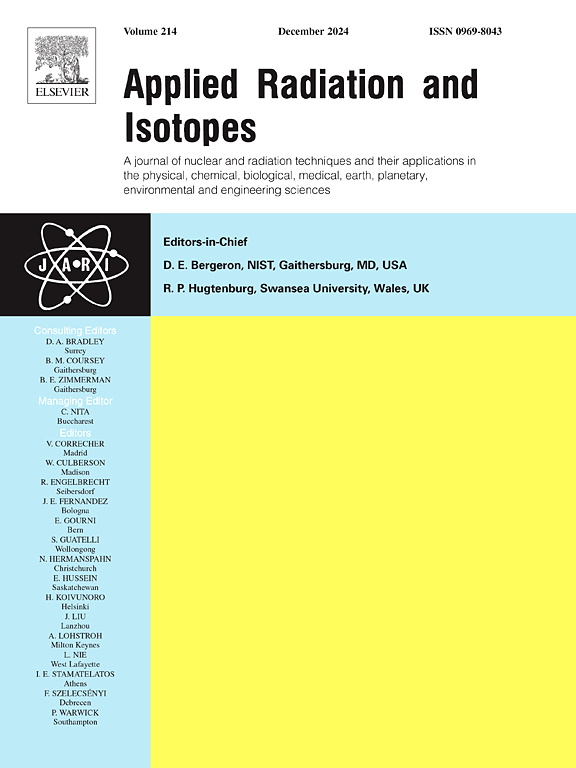用于硼中子俘获治疗的2.4 MeV静电串列加速器中子源束整形组件设计:蒙特卡罗研究
IF 1.6
3区 工程技术
Q3 CHEMISTRY, INORGANIC & NUCLEAR
引用次数: 0
摘要
本研究利用Monte Carlo N-Particle version 6.2为2.4 MeV, 15 mA质子加速器中子源设计了锂靶厚度和束形组件(BSA)系统。BSA组件由铅(Pb)、氟化镁(MgF2)、碳化硼(B4C)和钨(W)组成,分别用作反射器、慢化剂和准直器。通过改变BSA各部分的规格(面积和厚度)来分析通过BSA的中子的特性。系统的性能根据各种指标进行评估,包括超热中子通量、超热中子与热中子的比率、快中子污染、伽马污染和中子电流通量比。进行了蒙特卡罗模拟,以确定满足国际原子能机构建议的中子束要求的BSA规格。确定了锂靶厚度为90 μm,并在各种条件下验证了BSA的性能。对于产生最高超热中子通量的规格,BSA出口超热中子通量为8.89 × 108 cm−2 s−1,超热中子与热中子之比为425.54,中子电流通量比为0.7,快中子和伽马射线引起的剂量污染分别为1.20 × 10−13 Gy cm2和1.91 × 10−13 Gy cm2。本文章由计算机程序翻译,如有差异,请以英文原文为准。
Design of beam shaping assembly for 2.4 MeV electrostatic tandem accelerator-based neutron source for boron neutron capture therapy: A Monte Carlo study
In this study, the lithium target thickness and a beam-shaping assembly (BSA) system were designed using Monte Carlo N-Particle version 6.2 for a 2.4 MeV, 15 mA proton accelerator-based neutron source. The BSA components consist of lead (Pb), magnesium fluoride (MgF2), boron carbide (B4C), and tungsten (W) used for the reflector, moderator, and collimator, respectively. The specifications (area and thickness) of each BSA part were varied to analyze the characteristics of neutrons passing through the BSA. The system's performance was evaluated based on various indicators, including the epithermal neutron flux, ratio of epithermal to thermal neutrons, fast neutron contamination, gamma contamination, and neutron current to flux ratio. Monte Carlo simulations were conducted to determine BSA specifications that satisfied the neutron beam requirements recommended by the International Atomic Energy Agency. The lithium target thickness was determined to be 90 μm, and BSA's performance was confirmed under various conditions. For the specifications that yielded the highest epithermal neutron flux, the epithermal neutron flux at the BSA exit was 8.89 × 108 cm−2 s−1, the ratio of epithermal neutrons to thermal neutrons was 425.54, the neutron current-to-flux ratio was 0.7, and the dose contaminations due to fast neutrons and gamma rays were 1.20 × 10−13 Gy cm2 and 1.91 × 10−13 Gy cm2, respectively.
求助全文
通过发布文献求助,成功后即可免费获取论文全文。
去求助
来源期刊

Applied Radiation and Isotopes
工程技术-核科学技术
CiteScore
3.00
自引率
12.50%
发文量
406
审稿时长
13.5 months
期刊介绍:
Applied Radiation and Isotopes provides a high quality medium for the publication of substantial, original and scientific and technological papers on the development and peaceful application of nuclear, radiation and radionuclide techniques in chemistry, physics, biochemistry, biology, medicine, security, engineering and in the earth, planetary and environmental sciences, all including dosimetry. Nuclear techniques are defined in the broadest sense and both experimental and theoretical papers are welcome. They include the development and use of α- and β-particles, X-rays and γ-rays, neutrons and other nuclear particles and radiations from all sources, including radionuclides, synchrotron sources, cyclotrons and reactors and from the natural environment.
The journal aims to publish papers with significance to an international audience, containing substantial novelty and scientific impact. The Editors reserve the rights to reject, with or without external review, papers that do not meet these criteria.
Papers dealing with radiation processing, i.e., where radiation is used to bring about a biological, chemical or physical change in a material, should be directed to our sister journal Radiation Physics and Chemistry.
 求助内容:
求助内容: 应助结果提醒方式:
应助结果提醒方式:


